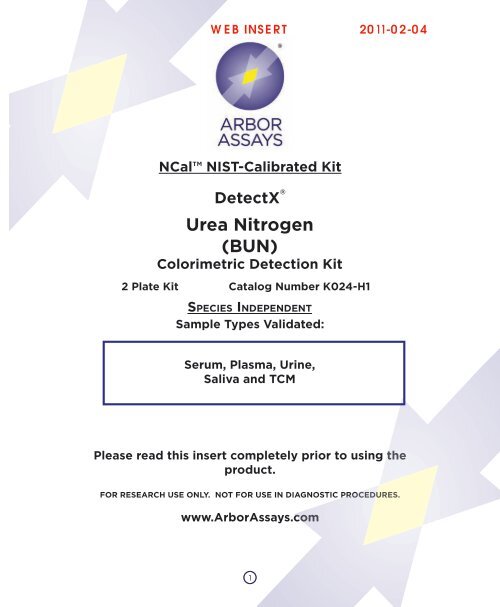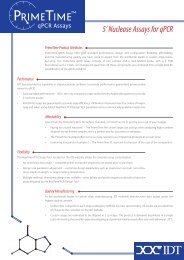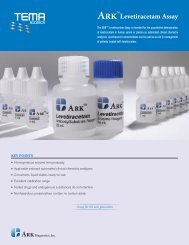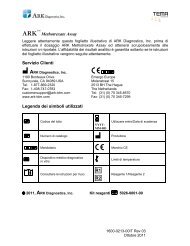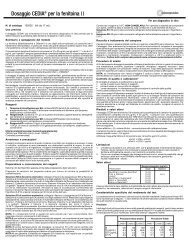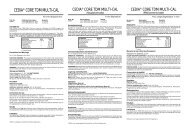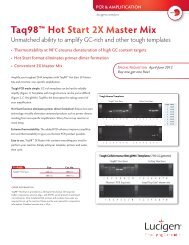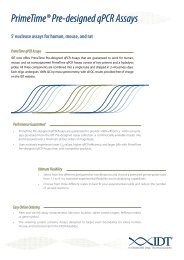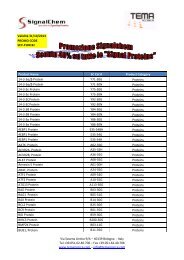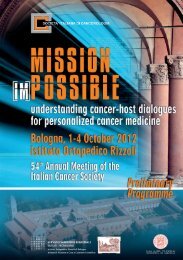Urea Nitrogen (BUN) - temaricerca.com
Urea Nitrogen (BUN) - temaricerca.com
Urea Nitrogen (BUN) - temaricerca.com
Create successful ePaper yourself
Turn your PDF publications into a flip-book with our unique Google optimized e-Paper software.
WEB INSERT 2011-02-04<br />
NCal NIST-Calibrated Kit<br />
DetectX ®<br />
<strong>Urea</strong> <strong>Nitrogen</strong><br />
(<strong>BUN</strong>)<br />
Colorimetric Detection Kit<br />
2 Plate Kit Catalog Number K024-H1<br />
Sp e c i e s In d e p e n d e n t<br />
Sample Types Validated:<br />
Serum, Plasma, Urine,<br />
Saliva and TCM<br />
Please read this insert <strong>com</strong>pletely prior to using the<br />
product.<br />
FOR RESEARCH USE ONLY. NOT FOR USE IN DIAGNOSTIC PROCEDURES.<br />
www.ArborAssays.<strong>com</strong><br />
1
WEB INSERT 2011-02-04<br />
Ta b l e Of Co n t e n t s<br />
Background 3<br />
Assay Principle 4<br />
Related Products 4<br />
Supplied Components 4<br />
Storage Instructions 4<br />
Other Materials Required 5<br />
Precautions 5<br />
Sample Types 5<br />
Sample Preparation 5<br />
Standard Preparation 6<br />
Assay Protocol 6<br />
Calculation of Results 7<br />
Typical Data 7-8<br />
Validation Data<br />
Sensitivity, Linearity, etc. 8-10<br />
Sample Values 10<br />
Warranty & Contact Information 11<br />
Plate Layout Sheet 12<br />
®<br />
2<br />
www.ArborAssays.<strong>com</strong>
WEB INSERT 2011-02-04<br />
Ba c k g r o u n d<br />
<strong>Urea</strong> is a by-product of protein metabolism by the liver, and is therefore removed from the blood<br />
by the kidneys. <strong>Urea</strong> freely filters through the glomerulous, but is reabsorbed by the renal tubules<br />
in a flow-dependent fashion. The higher the flow rate, the greater amount of urea nitrogen is<br />
cleared from circulation and eliminated through the kidneys. As a result, the level of circulating<br />
urea nitrogen, along with serum creatinine, serves as a primary measure of kidney function. Normal<br />
adult Blood <strong>Urea</strong> <strong>Nitrogen</strong> (<strong>BUN</strong>) levels should be between 7 and 21 mg urea nitrogen per<br />
100 mL blood (mg/dL) 1 . Azotemia, poor kidney function, will cause elevated <strong>BUN</strong> levels (≥ 50<br />
mg/dL) and is associated with acute kidney failure or injury, severe acute pancreatitis, congestive<br />
heart failure or gastrointestinal bleeding 2-5 . Azotemia also can occur with dehydration, as a result<br />
of alcohol abuse, or high protein diets. Lower than expected <strong>BUN</strong> levels are usually not clinically<br />
predictive, but are primarily associated with liver disease or malnutrition, including malabsorption<br />
and low protein diets 6 . Urine and saliva are considered to be acceptable non-invasive samples for<br />
measurement of urea nitrogen 7 .<br />
Serum creatinine is another metabolic waste product freely filtered by the glumerulous, but does<br />
not undergo tubular reabsorption. Its steady rate of elimination is frequently used to generate<br />
an index or ratio with <strong>BUN</strong> values for normalized evaluations. Easy to use Serum Creatinine and<br />
Urinary Creatinine Detection kits are also available from Arbor Assays (see Related Products).<br />
1. Laboratory reference values. <strong>Urea</strong> nitrogen (<strong>BUN</strong>). Rochester, Minn.: Mayo Foundation for Medical<br />
Education and Research; Nov. 2010.<br />
2. Waiker, SS and JV Bonentre. “Biomarkers for the diagnosis of acute kidney injury.” Nephron Clin.<br />
Pract. 2008. 109:c192-c197.<br />
3. Al Mofleh, IA. World J. Gastroent. “Severe acute pancreatitis: pathogenetic aspects and prognostic<br />
factors.” 2008. Congestive heart failure. 14(5):675-684.<br />
4. Iglesiase, J. et al. “Predictors of worsening renal function in adult patients with heart failure<br />
receiving re<strong>com</strong>binant human B-type brain natruiretic peptide (nesiritide).” Nephrol. Dial.<br />
Transplant. 2006. 21:3458-3465.<br />
5. Mayo Clinic. “Blood urea nitrogen (<strong>BUN</strong>) tests.”<br />
http://www.mayoclinic.<strong>com</strong>/health/blood-urea-nitrogen/MY00373/DSECTION=results<br />
6. Lum, G and S Leal-Khouri. “Significance of low serum urea nitrogen concentrations.”.<br />
Clin. Chem. 1989. 35(4):639-640.<br />
7. Akai, T, et al. “Salivary urea nitrogen as an index to renal function: a test strip method”.<br />
Clin. Chem. 1983. 29(10):1825-1827.<br />
®<br />
www.ArborAssays.<strong>com</strong><br />
3
WEB INSERT 2011-02-04<br />
As s ay Principle<br />
The DetectX® <strong>Urea</strong> <strong>Nitrogen</strong> (also called <strong>BUN</strong>) Detection Kit is designed to quantitatively measure<br />
urea nitrogen in a variety of samples. Please read the <strong>com</strong>plete kit insert before performing this<br />
assay. A urea nitrogen standard calibrated to NIST reference materials is provided to generate<br />
a standard curve for the assay and all samples should be read off the standard curve. Samples<br />
are mixed with Color Reagents A and B and incubated at room temperature for 30 minutes. The<br />
colored product is read at 450 nm. The concentration of urea nitrogen in the sample is calculated,<br />
after making a suitable correction for any dilution, using software available with most plate readers.<br />
The results are expressed in terms of mg/dL urea nitrogen. If samples are to be expressed in<br />
terms of mg/dL urea, the data can be converted using the multiplier 2.14.<br />
DetectX ® Kits<br />
Re l at e d Pr o d u c t s<br />
Serum Creatinine Detection Kits Catalog Number KB02-H1 /H2<br />
Retinol Binding Protein Urinary EIA Kit<br />
Cystatin C EIA Kit<br />
Hemoglobin Dual Range Detection Kit<br />
Catalog Number KU04-H1<br />
Catalog Number K012-H1<br />
Catalog Number K013-H1<br />
Su p p l i e d Co m p o n e n t s<br />
Clear 96 well Plates 2 Plates Catalog Number X003-2EA<br />
<strong>Urea</strong> <strong>Nitrogen</strong> Standard 250 µL Catalog Number C089-250UL<br />
<strong>Urea</strong> <strong>Nitrogen</strong> at 100 mg/dL in a special stabilizing solution.<br />
Calibrated to NIST Standard Reference Material Lot Number 912a<br />
Color Reagent A 15 mL Catalog Number X094-15ML<br />
An acidic solution of Color Reagent A. CAUTION: CAUSTIC<br />
Color Reagent B 15 mL Catalog Number X095-15ML<br />
An acidic solution of Color Reagent B. CAUTION: CAUSTIC<br />
St o r a g e In s t r u c t i o n s<br />
All <strong>com</strong>ponents of this kit should be stored at room temperature until the expiration date of the kit.<br />
®<br />
4<br />
www.ArborAssays.<strong>com</strong>
Distilled or deionized water free of urea.<br />
WEB INSERT 2011-02-04<br />
Ot h e r Mat e r i a ls Re q u i r e d<br />
96 well plate reader capable of reading optical absorption at 450 nm.<br />
Software for converting optical density (OD) readings from the plate reader and carrying out four<br />
parameter logistic curve (4PLC) fitting. Contact your plate reader manufacturer for details.<br />
Pr e c a u t i o n s<br />
As with all such products, this kit should only be used by qualified personnel who have had laboratory<br />
safety instruction. The <strong>com</strong>plete insert should be read and understood before attempting<br />
to use the product.<br />
The Color Reagents A and B are both strong acid solutions and should be handled like any<br />
laboratory acid.<br />
Sa m p l e Ty p e s<br />
<strong>Urea</strong> nitrogen is identical across all species and this kit will measure urea nitrogen from sources<br />
other than human. The end user should evaluate recoveries of urea nitrogen in samples from other<br />
species being tested. The kit will measure urea nitrogen in low concentration samples such as cell<br />
culture media, however the appropriate dilutions will have to be determined by the end user.<br />
If samples need to be stored after collection, we re<strong>com</strong>mend storing them at -70°C or lower, preferably<br />
after being frozen in liquid nitrogen. This assay has been validated for serum, plasma and<br />
urine. Samples containing visible particulate should be centrifuged prior to using.<br />
Sa m p l e Pr e pa r at i o n<br />
Dilute sample with distilled or deionized water prior to running in the assay. For serum or plasma,<br />
the re<strong>com</strong>mended dilution is ≥ 1:10 and ≥1:20 respectively. For urine, where concentrations of urea<br />
are higher, the re<strong>com</strong>mended final dilution is ≥ 1:100. For highly colored samples, dilution greater<br />
than 1:10 or 1:100 may be necessary.<br />
®<br />
www.ArborAssays.<strong>com</strong><br />
5
Sta n da r d Pr e pa r at i o n<br />
Standard Preparation<br />
<strong>Urea</strong> <strong>Nitrogen</strong> Standards are prepared by labeling seven tubes as #1 through #7. Briefly vortex to<br />
mix and then spin the vial of standard in a microcentrifuge to ensure contents are at bottom of<br />
the vial. Pipet 360 µL of distilled or deionized water into tube #1 and 200 µL into tubes #2 to #7.<br />
Carefully add 40 µL of the <strong>Urea</strong> <strong>Nitrogen</strong> Standard to tube #1 and vortex <strong>com</strong>pletely. Take 200 µL<br />
of the solution in tube #1 and add it to tube #2 and vortex <strong>com</strong>pletely. Repeat this for tubes #3<br />
through #7. The concentration of <strong>Urea</strong> <strong>Nitrogen</strong> in tubes 1 through 7 will be 10, 5, 2.5, 1.25, 0.625,<br />
0.3125 and 0.156 mg/dL.<br />
Use all Standards within 2 hours of preparation.<br />
WEB INSERT 2011-02-04<br />
Std 1 Std 2 Std 3 Std 4 Std 5 Std 6 Std 7<br />
Water Vol (µL) 360 200 200 200 200 200 200<br />
Addition Stock Std 1 Std 2 Std 3 Std 4 Std 5 Std 6<br />
Vol of Addition (µL) 40 200 200 200 200 200 200<br />
Final Conc (mg/dL) 10 5 2.5 1.25 0.625 0.3125 0.156<br />
As s ay Pr o t o c o l<br />
Use the plate layout sheet on the back page to aid in proper sample and standard identification.<br />
1. Pipet 50 µL of samples or appropriate standards into duplicate wells in the plate.<br />
3. Pipet 50 µL of water into duplicate wells as the Zero standard.<br />
4. Add 75 µL of Color Reagent A to each well using a repeater or multichannel pipet.<br />
5. Add 75 µL of Color Reagent B to each well using a repeater or multichannel pipet.<br />
6. Incubate at room temperature for 30 minutes.<br />
7. Read the optical density at 450 nm.<br />
®<br />
6<br />
www.ArborAssays.<strong>com</strong>
WEB INSERT 2011-02-04<br />
Ca l c u l at io n o f Re s u lt s<br />
Average the duplicate OD readings for each standard and sample. Create a standard curve by<br />
reducing the data using <strong>com</strong>puter software capable of generating a four-parameter logistic curve<br />
(4PLC) fit, after subtracting the mean OD’s for the blank. The sample concentrations obtained<br />
should be multiplied by the dilution factor to obtain neat sample values.<br />
Ty p i c a l d ata<br />
Sample Mean OD Net OD <strong>Urea</strong> <strong>Nitrogen</strong> Conc. (mg/dL)<br />
Zero 0.361 0 0<br />
Standard 1 2.184 1.823 10<br />
Standard 2 1.474 1.113 5<br />
Standard 3 0.993 0.632 2.5<br />
Standard 4 0.682 0.321 1.25<br />
Standard 5 0.530 0.169 0.625<br />
Standard 6 0.450 0.089 0.3125<br />
Standard 7 0.401 0.040 0.156<br />
Sample 1 0.686 0.325 1.24<br />
Sample 2 1.451 1.090 4.86<br />
Always run your own standard curves for calculation of results.<br />
Do not use these data.<br />
®<br />
www.ArborAssays.<strong>com</strong><br />
7
Typical Standard Curve<br />
WEB INSERT 2011-02-04<br />
2.0<br />
1.8<br />
1.6<br />
1.4<br />
Net OD<br />
1.2<br />
1.0<br />
Net OD<br />
0.8<br />
0.6<br />
0.4<br />
0.2<br />
0.0<br />
0 2 4 6 8 10<br />
<strong>Urea</strong> <strong>Nitrogen</strong> Conc. (mg/dL)<br />
Always run your own standard curves for calculation of results.<br />
Do not use these data.<br />
Validation Data<br />
Sensitivity and Limit of Detection<br />
Sensitivity was calculated by <strong>com</strong>paring the ODs for twenty wells run for each of the zero and<br />
standard #7. The detection limit was determined at two (2) standard deviations from the zero<br />
along the standard curve.<br />
Sensitivity was determined as 0.030 mg/dL.<br />
The Limit of Detection was determined in a similar manner by <strong>com</strong>paring the ODs for twenty wells<br />
run for each of the zero and a low concentration human sample.<br />
The Limit of Detection was determined as 0.065 mg/dL.<br />
®<br />
8<br />
www.ArborAssays.<strong>com</strong>
WEB INSERT 2011-02-04<br />
Linearity<br />
Linearity was determined by taking two human serum samples with known <strong>BUN</strong> concentrations<br />
and mixing them in the ratios given below. The measured concentrations were <strong>com</strong>pared to the<br />
expected values based on the ratios used.<br />
High serum Low Serum Observed Conc.<br />
(mg/dL)<br />
Expected Conc.<br />
(mg/dL)<br />
% Recovery<br />
80% 20% 1.32 1.32 99.9<br />
60% 40% 1.03 1.04 98.5<br />
40% 60% 0.767 0.771 99.5<br />
20% 80% 0.471 0.498 94.7<br />
Mean Recovery 98.1%<br />
1.4<br />
1.2<br />
Observed Conc. (mg/dL)<br />
1<br />
0.8<br />
Observed Conc. (mg/dL)<br />
y = 1.0274x -<br />
0.0352<br />
R 2 = 0.9996<br />
0.6<br />
0.4<br />
0.4 0.6 0.8 1 1.2 1.4<br />
Expected Conc. (mg/dL)<br />
®<br />
www.ArborAssays.<strong>com</strong><br />
9
WEB INSERT 2011-02-04<br />
Intra Assay Precision<br />
Three human samples were further diluted in water and run in replicates of 20 in an assay. The<br />
mean and precision of the calculated concentrations were:<br />
Sample <strong>BUN</strong> Conc. (mg/dL) %CV<br />
1 1.24 2.0<br />
2 2.29 1.9<br />
3 4.86 2.8<br />
Inter Assay Precision<br />
Three human samples were further diluted in water and run in duplicates in twenty assays run over<br />
multiple days by three operators. The mean and precision of the calculated concentrations were:<br />
Sample <strong>BUN</strong> Conc. (mg/dL) %CV<br />
1 1.30 3.2<br />
2 2.40 2.5<br />
3 5.24 3.4<br />
Sa m p l e Va l u e s<br />
Six random adult human serum and plasma samples were diluted and tested in the assay. The<br />
serum samples ranged from 15.6 to 22.3 mg/dL with an average of 18.6 mg/dL <strong>BUN</strong> while EDTA<br />
and heparin plasma samples ranged from 13.6 to 23.7 mg/dL with an average <strong>BUN</strong> of 18.1 mg/dL.<br />
Six random urines were also diluted and tested in the kit. The <strong>Urea</strong> <strong>Nitrogen</strong> values widely ranged<br />
from 37.2 to 1007.2 mg/dL as expected for random urine sampling.<br />
®<br />
10<br />
www.ArborAssays.<strong>com</strong>
WEB INSERT 2011-02-04<br />
Limited Wa r r a n t y<br />
Arbor Assays warrants that at the time of shipment this product is free from defects in materials<br />
and workmanship. This warranty is in lieu of any other warranty expressed or implied, including<br />
but not limited to, any implied warranty of merchantability or fitness for a particular purpose.<br />
We must be notified of any breach of this warranty within 48 hours of receipt of the product. No<br />
claim shall be honored if we are not notified within this time period, or if the product has been<br />
stored in any way other than outlined in this publication. The sole and exclusive remedy of the<br />
customer for any liability based upon this warranty is limited to the replacement of the product,<br />
or refund of the invoice price of the goods.<br />
Co n ta c t In f o r m at i o n<br />
For details concerning this kit or to order any of our products please contact us:<br />
Arbor Assays<br />
1514 Eisenhower Place<br />
Ann Arbor, Michigan 48108 USA<br />
Phone: 734-677-1774<br />
Fax: 734-677-6860<br />
Web: www.ArborAssays.<strong>com</strong><br />
E Mail Addresses:<br />
Info@ArborAssays.<strong>com</strong><br />
Orders@ArborAssays.<strong>com</strong><br />
Technical@ArborAssays.<strong>com</strong><br />
Contracts@ArborAssays.<strong>com</strong><br />
DetectX®, ThioStar® and the Arbor Assays logo are all registered trademarks.<br />
®<br />
www.ArborAssays.<strong>com</strong><br />
11
K006-F.1<br />
WEB INSERT 2011-02-04<br />
A<br />
B<br />
C<br />
D<br />
E<br />
F<br />
G<br />
H<br />
1 2 3 4 5 6 7 8 9 10 11 12<br />
©2011<br />
Printed on Forest Stewardship Council certified paper<br />
K024-H1 12 04Feb11


